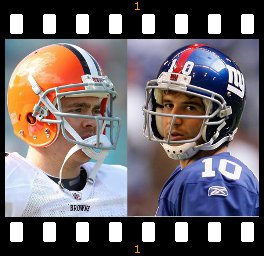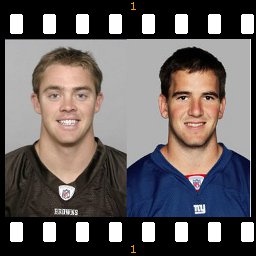 Browns Archive
Browns Archive  Colt, Eli, & The Question of Quarterback Stats
Colt, Eli, & The Question of Quarterback Stats
 Whether it’s RG3, Matt Flynn, or Johnny Utah (remember, he was an OSU All-American before becoming an undercover surfer for the FBI), it seems a foregone conclusion that the Cleveland Browns will have a new quarterback in 2012. To most observers, the Colt McCoy “assessment period”-- as condescendingly spouted ad nauseam by Mike Holmgren— was never more than lip service; an empty gesture to a dead man walking. But what if the Walrus actually meant what he said and said what he meant? What if the Browns really are still trying to figure out what they’ve got in their doe-eyed, tough-nosed kid out of Texas? And how would such a thing even be accomplished?
Whether it’s RG3, Matt Flynn, or Johnny Utah (remember, he was an OSU All-American before becoming an undercover surfer for the FBI), it seems a foregone conclusion that the Cleveland Browns will have a new quarterback in 2012. To most observers, the Colt McCoy “assessment period”-- as condescendingly spouted ad nauseam by Mike Holmgren— was never more than lip service; an empty gesture to a dead man walking. But what if the Walrus actually meant what he said and said what he meant? What if the Browns really are still trying to figure out what they’ve got in their doe-eyed, tough-nosed kid out of Texas? And how would such a thing even be accomplished?
Well, for starters, you’ve always got the eyeball test—Holmgren and Heckert snuggling up with a drum of popcorn in the film room, re-screening the horror movie marathon that was Colt McCoy’s sophomore season in Cleveland. The problem, of course, is that appearances alone can be deceiving. At age 25, what Colt currently lacks in reaction time or pure arm strength, he may very well make up for in character, smarts, and intestinal fortitude. ...Maybe? Either way, those oft-discussed intangibles can prove a tad unreliable, too, if for no other reason than they are just that—intangible. At times like these, you really need concrete, irrefutable evidence of how your player has performed. And for ages, that language of assessment has gone by the name of statistics.
People complain about them enough. They say “numbers aren’t everything.” But when it’s time to gage an athlete’s value—pretty much every coach, ESPN reporter, and rambling sports radio caller wind up using statistics to put everything neatly in perspective. Even when those statistics have proven misleading and outdated-- like saves in baseball or sacks in football—it rarely stops us from reading into them.
Now, consider the following example of numbers being used to frame a potentially enlightening comparison of two players. One of them is the Browns’ beleaguered, on-the-outs QB Colt McCoy. The other is your newly crowned Super Bowl MVP and—according to many talking heads—Canton-bound Giants signal-caller Eli Manning.
Eli Manning vs. Colt McCoy: First Two NFL Seasons (’04-’05 and ’10-’11 respectively)
............................................. Manning…………………….….. McCoy………………..
Games Started……......… 23 (12-11) ……………………… 21 (6-15) ……….
Completion % ……….…. 51.6% (389-754) ……………… 58.4% (400-685) ……
Passing Yards ………..... 4,805 (6.37 yards/attempt) ....… 4,309 (6.30 y/a) …..
TD/INT ………………..…. 30 TD / 26 INT …………………. 20 TD / 20 INT ……...
Rush Yards/Game …….. 4.6 ……………………………….. 16.6 ………..
QB Rating …………....…. 70.5 ……………………………… 74.5 …………..
 Aside from both of these guys looking like your fourth grade classmate who liked to eat glue, let's see what else they have in common. Manning was the hugely publicized first pick in the 2004 NFL Draft, and became the starter halfway through his rookie season with the Giants, playing in a big market with some considerable weapons at his disposal, including Tiki Barber in the backfield, Jeremy Shockey at tight end, and a receiving corps of Amani Toomer and (by his second season) Plaxico Burress. McCoy, meanwhile, was a third round pick carrying fairly low expectations. Like Manning, he took over the starting role halfway through his rookie season, but his targets were slightly less accustomed to Pro Bowl nods, with a rotation of green kids like Mo Massaquoi, Brian Robiskie, and Greg Little lining up on either side of him.
Aside from both of these guys looking like your fourth grade classmate who liked to eat glue, let's see what else they have in common. Manning was the hugely publicized first pick in the 2004 NFL Draft, and became the starter halfway through his rookie season with the Giants, playing in a big market with some considerable weapons at his disposal, including Tiki Barber in the backfield, Jeremy Shockey at tight end, and a receiving corps of Amani Toomer and (by his second season) Plaxico Burress. McCoy, meanwhile, was a third round pick carrying fairly low expectations. Like Manning, he took over the starting role halfway through his rookie season, but his targets were slightly less accustomed to Pro Bowl nods, with a rotation of green kids like Mo Massaquoi, Brian Robiskie, and Greg Little lining up on either side of him.
So, what can we take away from the fact that McCoy posted a much higher completion percentage, lower pick rate, comparable yards-per-attempt average, better scrambling numbers, and a superior QB rating to the mighty Eli at the same stage in their careers? Well, from a talent evaluation standpoint, pretty much nothing. Colt backers could certainly point at these details and say that patience is a virtue, and that McCoy’s maturation process could logically approach Manning’s given time and better talent around him. But there is no real science in play here, because two objects starting at the same point are not automatically bound for the same destination. The variables in play will never be identical. And besides, when it comes to perception of numbers, the biggest one is the WINS column. And in Eli’s second season, the Giants went 11-5 and made the playoffs. If Colt could say that about his sophomore campaign, odds are Holmgren doesn’t have to talk about any further assessment period. As in the Tim Tebow insanity, wins are the one stat that will trump a lot of uglier ones.
So, do quarterback stats ever really help tell the tale of a player’s true worth to his team? If we look back into the Cleveland Browns record book, for example, shouldn’t every major passing category start and end with Graham, Ryan, Kosar, and Sipe? They’re the ones we remember, after all-- the beloved QBs that set the bar for all who have followed. Well… turns out that, while numbers never lie, they can at least omit some information.
Cleveland Browns All-Time Leaders (minimum 500 pass attempts)
Career Completion %
Kelly Holcomb 63.7%
Charlie Frye 62.5%
Tim Couch 59.8%
Bernie Kosar 58.8%
Colt McCoy 58.4%
Milt Plum 57.9%
Vinny Testaverde 57.9%
Brian Sipe 56.5%
Otto Graham 55.8%
Paul McDonald 53.6%
"Accuracy, dammit! Give me a quarterback that finds his target and hits it!" Well then, I give you the holy trinity of Kelly Holcomb, Charlie Frye, and Tim Couch. Such are the consequences of an expansion team’s timid, screen-oriented offense.
QB Rating
Milt Plum 89.9
Otto Graham 86.6
Kelly Holcomb 83.3
Bernie Kosar 81.6
Frank Ryan 81.4
Vinny Testaverde 80.9
Tim Couch 75.1
Brian Sipe 74.8
Colt McCoy 74.5
Bill Nelsen 72.1
QB rating; the all-encompassing measure of a passer, supposedly. I guess it’s possible we never have given Milt Plum his proper due, but then there’s Kelly Holcomb again! A better passer than Bernie?! Well, not in the minds of anyone who watched them, of course. And sorry, Brian Sipe, but Tim Couch was evidently the more effective Cleveland QB.
Interception Percentage
Bernie Kosar 2.6%
Colt McCoy 2.9%
Milt Plum 3.6%
Vinny Testaverde 3.7%
Tim Couch 3.9%
Charlie Frye 4.1%
Kelly Holcomb 4.1%
Derek Anderson 4.1%
Brian Sipe 4.3%
Paul McDonald 4.8%
(Frank Ryan and Graham both over 5%)
Everyone knows that Kosar was one of the all-time greats at not turning the ball over. He held the record for most attempts without a pick for quite a while. But who’s right on his tail? Why, it’s the overmatched, mistake-prone Mr. McCoy! And would you believe that Derek Anderson was more trustworthy with the ball than Otto Graham? The proof is in the stat pudding (be warned, though, it has a bad aftertaste).
Yards/Pass Attempt
Otto Graham 9.0
Milt Plum 8.2
Frank Ryan 7.6
Bill Nelsen 7.4
Vinny Testaverde 7.3
Bernie Kosar 7.0
Paul McDonald 6.9
Brian Sipe 6.9
Kelly Holcomb 6.8
Tim Couch 6.5
Even if Otto Graham did feel like throwing a little dink and dunk pass, he had Marion Motley to turn that sucker into 20 yards.
Winning Percentage (16+ starts)
Otto Graham 80.3%
Frank Ryan 68.4%
Bill Nelsen 66.7%
Milt Plum 64.7%
Vinny Testaverde 51.6%
Brian Sipe 50.9%
Bernie Kosar 50.5%
Mike Phipps 47.1%
Derek Anderson 47.1%
Paul McDonald 38.1%
On second thought, maybe even the WINS category doesn’t affect our perceptions as much as blind devotion. 1980s heroes Brian Sipe and Bernie Kosar-- whom most Browns fans would gladly give their remaining kidneys to in a pinch—were both essentially .500 quarterbacks during their lengthy tenures in Cleveland.
QB Rush Yds Per Game
Colt McCoy 16.6
Mike Phipps 13.1
Charlie Frye 13.1
Frank Ryan 12.3
Tim Couch 9.0
Otto Graham 7.0
Brian Sipe 6.1
Vinny Testaverde 4.7
Derek Anderson 4.6
Milt Plum 3.5
No one ever compared Colt to Michael Vick, and his rushing plays were rarely ever drawn up in the huddle. In fact, they were more the consequence of having receivers incapable of separation. Nonetheless, no Browns quarterback has ever made something out of nothing with his legs as consistently as McCoy.
I suppose I could expand this analysis beyond the Browns into the NFL as a whole, considering the league’s Top 25 All-Time QB Rating list includes the likes of Chad Pennington (#12), Trent Green (#19), David Garrard (#22), and Shaun effing Hill (#24)! But I think you get the idea. The back of the football card, no matter how complex it gets, should generally be viewed for entertainment purposes only.
As for whether Colt McCoy has Eli Manning potential? The Magic 8-Ball says “How the hell should I know?”
- NBA Announces 2013-2014 Schedule
- Browns Ink Sharknado
- Sharknado A No-Show For Rookie Camp
- Trent Richardson Out Until Training Camp
- Browns Sign Brandon Jackson
- Carrasco Suspended Eight Games
- Browns Add to Wide Receiver Depth with David Nelson
- Browns Need to Learn from Past Draft Mistakes
- Browns Release Chris Gocong and Usama Young
- Browns Missing on Grimes Disappointing, But Not The End
The TCF Forums
- Movies coming out
rebelwithoutaclue (Tuesday, January 21 2014 12:56 PM) - 2015 Recruiting
jclvd_23 (Tuesday, January 21 2014 12:38 PM) - The 2014 Offseason Thread
Larvell Blanks (Tuesday, January 21 2014 12:25 PM) - Official- Browns Coach Search/Rumors
Larvell Blanks (Tuesday, January 21 2014 11:53 AM) - Chris Grant's first 3 drafts
Kingpin74 (Tuesday, January 21 2014 10:13 AM) - Mike Brown
YahooFanChicago (Monday, January 20 2014 11:15 PM) - 2014 Hoops Hockey Hijinx
jpd1224 (Monday, January 20 2014 4:44 PM) - 2014 Recruiting
jclvd_23 (Monday, January 20 2014 2:26 PM) - Wish List - #4 Pick
Hikohadon (Monday, January 20 2014 1:26 PM) - #1 overall pick Anthony Bennett
TouchEmAllTime (Sunday, January 19 2014 1:28 PM)


